How was the Boeing B-52 Stratofortress bomber created?
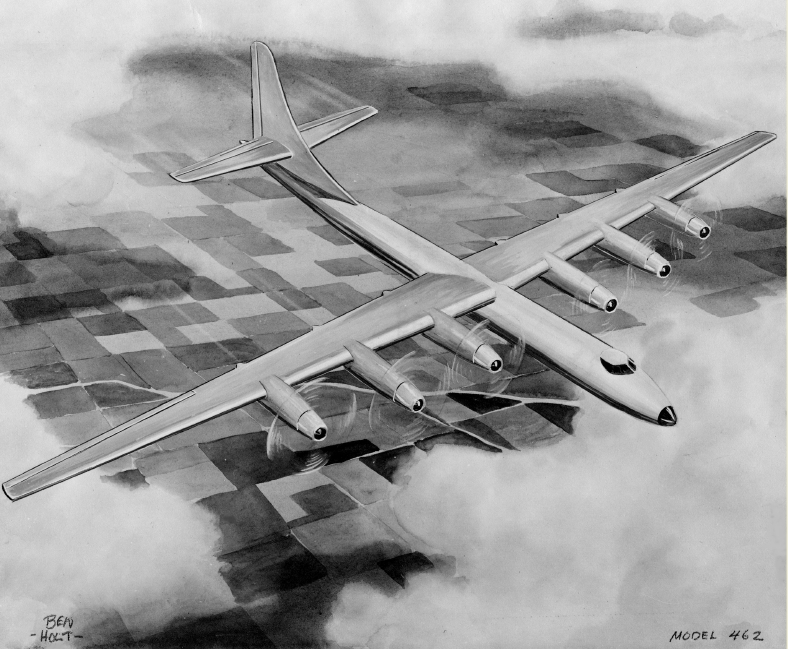
The program to create a promising long-range strategic bomber, which was supposed to replace the existing Boeing B-29 Superfortress, as well as those developed by Convair B-36 Peacemaker, began in the mid-forties. Already in June 1945 of the year, a few months before the end of the Second World War, the development of requirements for promising long-range bombers began. These studies took into account the experience of using long-range aviation in the Pacific theater of military operations, in particular during the last period of the war. After analyzing, the US military realized that the new bomber must surpass all available in range. Such an opportunity would allow strikes against enemy targets without using advanced airfields, which during the war often had to be beaten off from the enemy.
November 23 The US military department approved the requirements for a promising long-range bomber. It is noteworthy that according to some characteristics, this machine was supposed to surpass the B-1945 under construction, which first took to the air only in August of the 36. This pace of work clearly shows how much attention was paid to the development of new strategic strike systems.
In accordance with the requirements of the autumn 1945, the prospective aircraft was supposed to reach a speed of at least 480 km / h, rise to a height above 10 km and have a range of 8000 km. It was planned to include five pilots and several shooters in the crew. The number of the latter was supposed to be determined in accordance with the capabilities of defensive weapons. It was supposed to protect the aircraft from enemy fighters using several remote-controlled turrets with 20-mm automatic guns. The payload was set at 4535 kg (10 ths pounds).
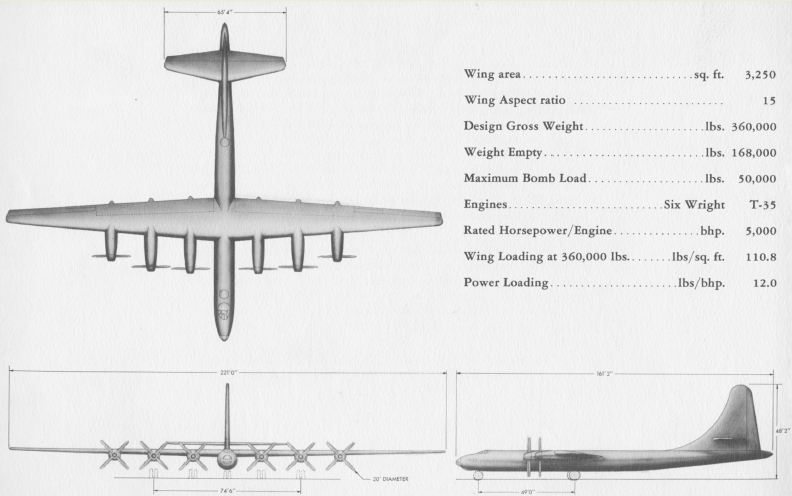
The general scheme and the main characteristics of the Model 462.
The picture says:
Wing area - 302 sq.m.
Wing Extension - 15
Gross weight - 159 tons
Empty weight - 76 tons
Maximum combat load - 23 tons
Engines - Six T-35
Engine power - 5000 horses
Wing load with weight in 159 tons - 0,5 tons / sq.m.
Power load - 33 kilogram / hp.
By August, 1946, the project was finalized and submitted to the competition
13 February 1946, the military handed over to the industry a package of documents for a new development program for a promising bomber. According to some reports, by this time the requirements have been adjusted. The new aircraft was to be equipped with turboprop or turbojet engines. From the piston decided to give up. Three companies expressed their desire to take part in the project: Boeing, Martin and Convair. After reviewing the requirements for a promising aircraft, aircraft manufacturers began to develop preliminary versions of the project. As a result of the development of a strategic bomber B-52 took the company Boeing, consider only its proposals.
The first project appeared called Model 462. In the description of this project it was stated that it used the newest technologies and technical solutions. Nevertheless, as can be seen from the diagrams and photographs of the models, the new aircraft should have been very similar to the existing B-17 and B-29, outwardly differing only in size from them. The plane was supposed to have a length of about 50 m and a wing span of about 63-65 m. According to calculations, the weight of an empty aircraft could exceed 75 t, and the maximum take-off weight reached 160 t. However, the weight of the payload exceeded five times the initial requirements - in the long large cargo hold it was possible to transport more than 22,5 tons of bombs.
From the point of view of aerodynamics, the Model 462 was similar to an enlarged B-29 with similar contours and wing shape. In addition, from the old project was supposed to borrow some layout ideas. So, in the forward part of the fuselage there should have been an airtight cabin with 10 seats for crew members. All systems, including defensive armament, were planned to be controlled with the help of remote controls at crew workplaces.
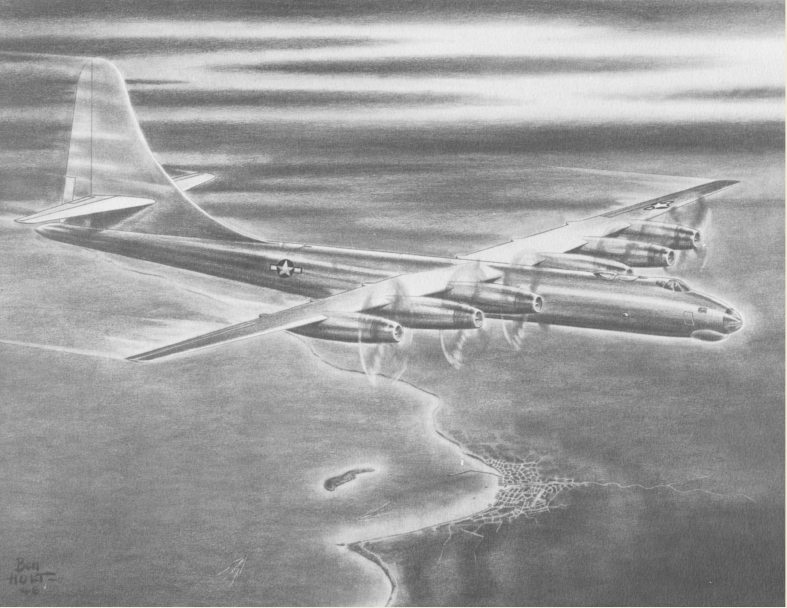
Modified Model 462. Visible numerous borrowings from the project XB-36
Of great interest was the proposed power plant. On the wing of a Model 462 bomber were six Wright T-35 Typhoon hpX X turbine propellers. Turboprop engines were chosen for reasons of economy and to ensure the greatest possible flight range. Turbojet engines of that time had a slightly higher power and could provide greater flight speed, but consumed much more fuel and thereby reduced the range. Already at the stage of creating a preliminary project an interesting technical solution was used. The design of all six engine nacelles was as unified as possible to facilitate production and maintenance.
The large take-off weight did not allow the classic three-support chassis used in previous Boeing bombers to be preserved. Instead, he had to use the bike with two main racks, each of which carried two wheels. In addition, in the second and fifth engine nacelles had to be additional racks that prevent the machine from collapsing on its side.
To protect against enemy fighters, the prospective bomber had to use numerous automatic guns. It was proposed to place two turrets with four 20-mm guns on each in the forward part of the fuselage and in the tail section in front of the gargrot. In addition, there should have been another installation with four implements in the tail. The dimensions of the compartments made it possible to transport up to 3600 shells per gun (according to other data, on all guns of each turret). Fuselage turrets were proposed to be removed in the fuselage to improve the aerodynamics of the aircraft. All guns were to be controlled remotely, with consoles in the bow pressurized cabin.
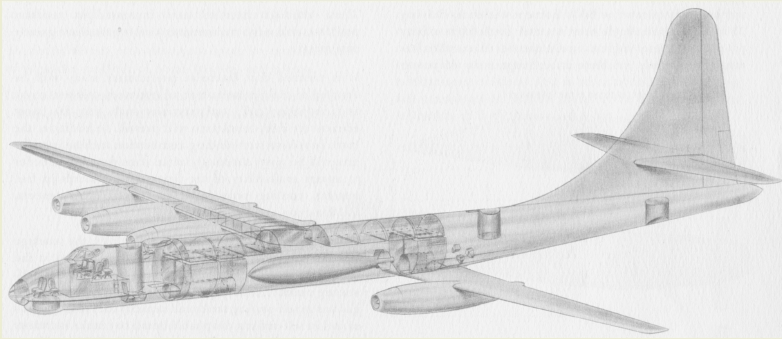
Boeing Model 462 - sectional view. In the bomb bay you can see the 20 ton bomb Т12
Naturally, the proposed version of the Model 462 project was not final. In the course of further development, several versions of this bomber were created, differing in various units and aggregates, as well as in other nuances of the design. To continue this development was planned in the case of obtaining approval from the customer.
In the spring of 1946, the US Department of Defense stopped accepting applications for the competition and took up the analysis of proposals received. The first acquaintance with the proposed projects showed that none of them fully meet the requirements. However, the favorites were soon decided. The project of the Martin company was considered unpromising, because of what only Boeing Model 462 and Convair LRHBA aircraft were compared in the future. The final choice was extremely difficult. Each of the proposed aircraft had its advantages and disadvantages. At the same time, none of them had a clear advantage over the other. At the end of May, the 46 of the military was determined. It was decided to continue work on the Model 462 project, since this bomber was easier to manufacture and operate, although it was inferior to the competitor in some flight characteristics.
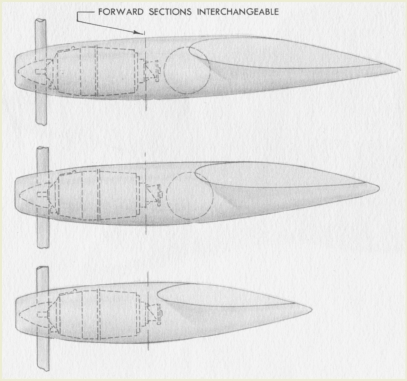 In early June of the same year, Boeing received a notice of winning the competition. A little later, the project received a new designation, XB-52, and at the end of the month a contract was signed for the construction of a model of the aircraft. In addition, it was necessary to continue the design work. For some time, specialists at Boeing continued to calmly develop a bomber, but in the fall the situation changed dramatically.
In early June of the same year, Boeing received a notice of winning the competition. A little later, the project received a new designation, XB-52, and at the end of the month a contract was signed for the construction of a model of the aircraft. In addition, it was necessary to continue the design work. For some time, specialists at Boeing continued to calmly develop a bomber, but in the fall the situation changed dramatically.The fact is that the customer eventually began to doubt the correctness of his choice. The Model 462 bomber did meet many requirements, but didn’t have enough range. In addition, the proposed design had a limited modernization potential, which hampered its development in the future.
The authors of the project saw the existing problem and constantly tried to fix it. Thus, in one of the first versions of the project, which appeared immediately after winning the competition, it was proposed to use two outboard fuel tanks under the extreme engine nacelles. This refinement reduced the speed a bit, but allowed to increase the range by about 500 km. Later in the finalized project called Model 462-4, two more tanks were added under the central gondolas, however, for this, the design of a number of important components had to be seriously redone. In particular, the chassis has undergone major modifications.
Nevertheless, the ideas of the Model 462-4 project did not justify themselves. Additional tanks under the four engine nacelles seriously increased the frontal resistance of the aircraft, because of which it was not possible to achieve a significant increase in flight range. The achieved range increase simply could not justify the complexity of the design. As a consequence, in the project Model 462-5 was used the chassis of the old design, and additional fuel tanks are located inside the fuselage.
The most important innovation in the later versions of the Model 462 project was the new Wright T35-1 turboprop engines, which had lower fuel consumption in comparison with their predecessors. To install these engines had to change the design of the engine nacelles, as well as redo some parts of the aircraft. After these modifications, the aircraft got heavy by about 2 t, however, the flight range increased by 400 km. At the same time, the aircraft maintained acceptable dimensions and take-off weight.
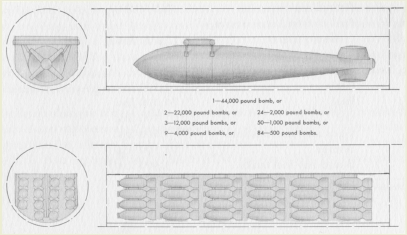 In the fall, the latest version of the Boeing Model 462 project was transferred to the Research and Development (RAND) organization. Her staff studied the project and made their verdict. The proposed bomber was considered obsolete and overweight. Claims caused the composition of defensive weapons, as well as the design of the plumage of a large area. Finally, the very size of the aircraft was the reason for criticism. It was recommended to reduce it by almost one and a half times, since the available dimensions were one of the main factors that reduced the maximum possible speed and range.
In the fall, the latest version of the Boeing Model 462 project was transferred to the Research and Development (RAND) organization. Her staff studied the project and made their verdict. The proposed bomber was considered obsolete and overweight. Claims caused the composition of defensive weapons, as well as the design of the plumage of a large area. Finally, the very size of the aircraft was the reason for criticism. It was recommended to reduce it by almost one and a half times, since the available dimensions were one of the main factors that reduced the maximum possible speed and range.Boeing was critical of the RAND report. Aircraft manufacturers were confident that they were right and did not want to redo the project, because they believed that the reduction in size would adversely affect all characteristics of the aircraft, from speed and range to payload and ability to defend against fighters. However, the military agreed with the analysis of the project. The project developers were forced to agree with the customer and engage in project changes. It is noteworthy that one of the main supporters of the processing project was General Curtis LeMay, who at that time held the post of Deputy Chief of Staff of the Air Force for new research and development. It was he who for some time accompanied the development of the project XB-52.
Carrying out the order of the military, the company Boeing began a radical processing of the proposed aircraft. Project Model 464 implied a proportional reduction in the size of the aircraft, as well as a reduction in the number of engines. Model 464 aircraft had to be equipped with four engines and have a take-off weight of no more than 100-105 t. With such dimensions, it was possible to maintain the necessary fuel stock, which allowed to keep the range at least at the level of the Model 462 bomber.
However, the new project also did not suit the military. The command of the Air Force in the person of General K. Lemey believed, not without reason, that a promising strategic bomber should have a higher flight speed. In December, 1946, the company Boeing received the task to change the project Model 464 in order to increase cruising speed to 640 km / h and flight range to 12 thousand km. In addition, it was necessary to ensure the possibility of transportation and use of nuclear bombs.
The design variants modified in accordance with such requirements were given the designations “464-16” and “464-17”. The overall architecture of these aircraft has remained unchanged, but various structural elements have undergone major modifications. As a result, the maximum take-off weight reached 180 tons, the wingspan was 62,5 m, and the length - 47,5 m. The range of these aircraft options, according to calculations, almost met the requirements of the customer. The maximum speed (at an altitude of 10,6 km) was to reach 705-710 km / h.
It should be noted that the Model 464-16 and Model 464-17 projects differed only in the intended composition of the payload and the accompanying characteristics. Thus, the aircraft "464-16" could carry a nuclear weapon weight up to 4,5 t and fly to the maximum possible range. The main objective of this machine was the attack of important objects in the territory of a potential enemy. Bomber "464-17", in turn, was intended for conflicts with the use of conventional weapons. For this reason, he could fly at different ranges with different combat load. Thus, the maximum weight of the bombs, which seriously reduced the flight range, could reach 40,8 t. For a flight at maximum range, the weight of the load was reduced by 8-10 times.
The proposal to build two aircraft, adapted to perform different combat missions, looked interesting and promising. Nevertheless, such a project turned out to be too expensive and therefore did not suit the military. The Air Force abandoned the Model 464-16 bomber. It was decided to continue work on the aircraft "464-17", which was to receive special equipment for the use of nuclear weapons. However, the "universal" bomber, in contrast to the specialized carrier of atomic bom, had an insufficient maximum flight range. Fortunately for the project, by that time certain progress was achieved in the field of in-flight refueling, which made it possible to compensate for the lack of transported fuel.
Project Model 464-17, with the exception of some nuances, satisfied the customer. The claims were caused by some characteristics that did not fully meet the requirements of the customer, as well as the estimated cost of construction and operation of the new equipment. Calculations showed that the allocated funding will allow to build only a hundred new aircraft, while the troops needed many times more. At the beginning of 1946, an important decision was made. The Air Force did not close and did not approve the project as it was, but gave the designers half a year to look for a way out of the current situation. After the deadline, the military planned to consider a new version of the project and determine its fate.
The result of this work was the project Model 464-29. This version of the bomber had major differences from all previous ones. For the first time in the framework of the XB-52 program it was proposed to use not a straight, but an arrow-shaped wing. With dimensions and weight at the level of “464-17”, the aircraft “464-29” had a tapering wing with swept 20 °. The rear edge of the wing remained straight. On the wing there were four engine nacelles with T35-1 engines. The layout of the internal fuselage volumes and the chassis design have changed again. According to calculations, the new wing allowed us to develop speeds above 700 km / h.
In December 1947, a special committee established to support strategic bombers' projects issued new requirements for such equipment. The XB-52 was supposed to fly over a distance of more than 12,5 thousand km and develop cruising speed at the level of 800-880 km / h. The Model 464-29 project in its current form did not meet most of the requirements, which caused the entire program to be in jeopardy. Only a few days after the approval of the new requirements, the Air Force was ready to terminate the contract with Boeing, but its leadership managed to convince the military to wait with such a radical decision. At the very beginning of the next 1948, the Ministry of Defense notified the developers that it was not going to curtail the project, but was going to explore alternative proposals. In particular, the military drew attention to the project Northrop XB-49.
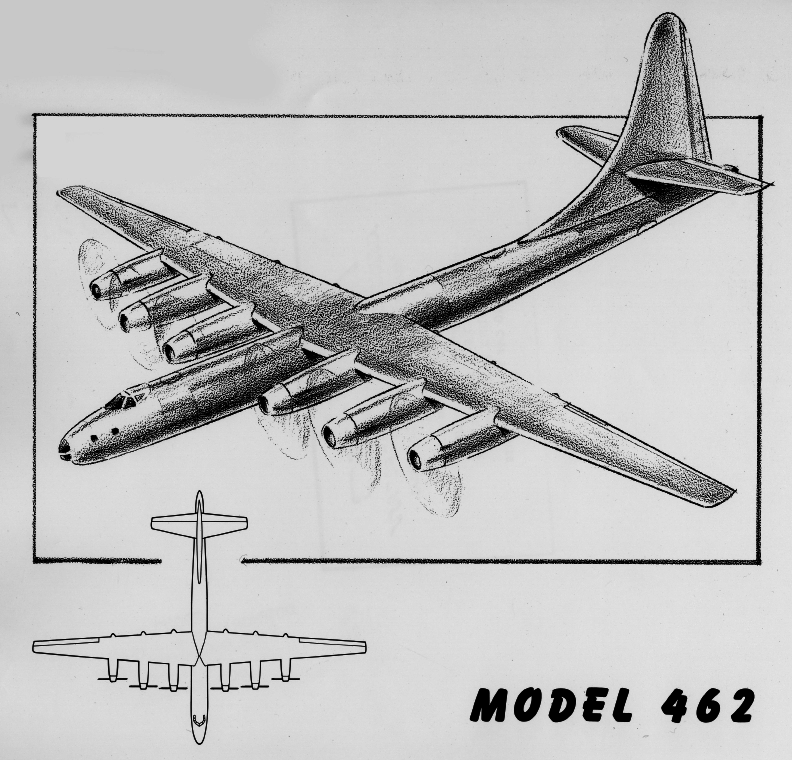
Illustration for the Boeing Model 462 brochure. In this illustration, the turret was removed.
Already in January, the 48-th project was presented Model 464-35, which continued to reduce the size and weight. It was proposed to equip this aircraft with a swept wing with a span of 56 m, and the total length of the vehicle did not exceed 40 m. The maximum take-off weight could be reduced to 125-130 t. At the same time, the aircraft could reach speeds of more than 12,5 km / h at 800 km. The estimated maximum flight range exceeded 18,7 thousand km. An important difference with the Model 464-35 aircraft was a four-engine power plant using twin coaxial propellers.
By the spring of 1948, the Model 464-35 project was slightly improved, although some characteristics of this aircraft still did not meet the requirements of the customer. And yet in April, the 48-th Air Force ordered the continued development, construction and testing of two XB-52 bombers based on the 464-35 project. This decision was affected by a change in the military-political situation in Europe. Political problems forced to change their views on equipment that did not fully meet the requirements.
In May 1948, Boeing’s specialists again had to tackle the new project. The command of the Air Force proposed to work out a version of the bomber with turbojet engines. Previously, these engines were not considered suitable for use on long-range bombers, as they had excessive fuel consumption. However, as part of the XB-52 project, it was decided, at a minimum, to test the possibility of using such units.
In July, 48-I completed the work on the project Model 464-40. This version of the project was a modified "464-35" using new engines and related equipment. The main dimensions and weight of the structure were maintained at the same level. The Model 464-40 bomber was equipped with eight Westinghouse XJ40-13-12 turbojet engines arranged in pairs on pylons under the wing. With such a power plant, while maintaining the overall characteristics, it was possible to increase the maximum flight speed by about 12-15 km / h.
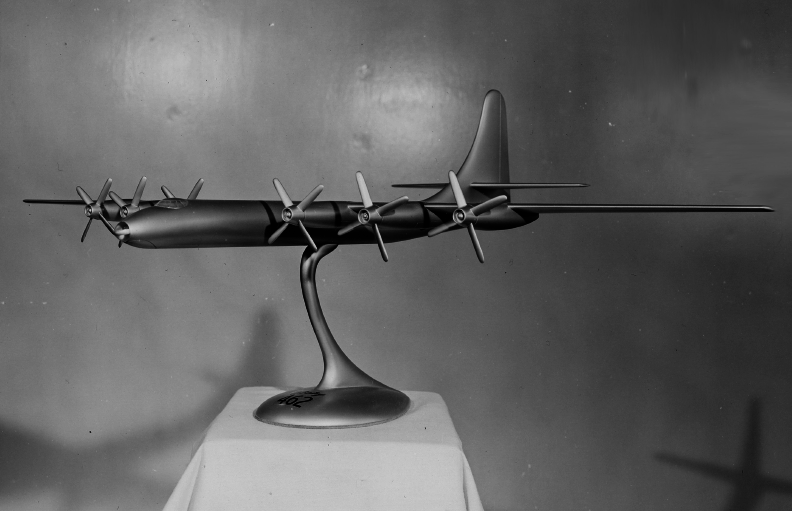
Scale model of the Boeing Model 462. Gun turrets removed
The jet bomber looked extremely interesting, but the engine fuel consumption was still too high. As a result, Boeing received an order to continue parallel development of projects using turboprop and turbojet engines. The latter had great prospects, but modern equipment of this class could not be compared with turboprop engines in terms of efficiency.
On October 21, 1948, a regular meeting was held with the participation of representatives of the Air Force and the aviation industry, which determined the course of further work on the program. The military announced that they want a bomber based on the Model 464-35 project, equipped with turbojet engines. To meet this requirement, Pratt & Whitney had to continue their JT3 project. Interestingly, this company has already taken part in the XB-52 project. Her task was to develop an alternative turboprop engine that could be used if the Wright T35 project failed.
Immediately after the meeting, Boeing employees right at the hotel, not returning home to Seattle, began to make preliminary calculations of the car with the desired appearance. So the first sketches of the Model 464-49 project appeared. This bomber was supposed to have the same dimensions as previous designs, but it was noticeably heavier: the maximum weight reached 150 t. The most important feature of the project was the new wing. It was proposed to use a wing span of 56 m with a sweep 35 °. At the same time, the wing area increased from 130 sq. m to 371 square. This was the largest wing among all the projects created under the XB-52 program.
On pylons under the wing, it was proposed to hang eight J57 / JT3 turbojet engines. Using such a propulsion system, the aircraft could reach speeds of up to 910 km / h. With a combat load 4,5 t range reached 5400 km. A curious feature of the Model 464-49 project was the fact that the use of turbojet engines made it possible to get rid of some of the problems inherent in turboprop engines, and in addition, the J57 and T35-1 projects had approximately the same completion time.
On Friday, January 21, 1949, a meeting was held at which it was proposed to make a jet aircraft. Already on Monday, Boeing employees brought to the new meeting not only papers with calculations, but also a small model of the Model 464-49 aircraft made the day before. In creating the model, the designers were assisted by the nearest hobby store, where they bought a cork tree, from which a miniature plane was carved. The military liked the proposal, they ordered to stop all work on the bomber with turboprop engines. At the same time, Pratt & Whitney was tasked with completing the development of the J57 engine.
By the end of January, a package of necessary documentation was prepared, soon approved by the customer. The Boeing Model 464-49 project met with some misunderstanding in certain circles of the Air Force command, but it was already approved by the responsible persons, so it was too late to resist. A serious danger to the project was the cuts in the military budget undertaken by the administration of President Harry Truman. Nevertheless, the command of the Air Force managed to defend a promising project.
By the end of April, a full-size model of the future XB-49 was built on 52, which at the end of the month was shown to representatives of the air force. In general, the development suited the customer, but the promising engine J57 still had insufficient performance. Due to too high fuel consumption, such engines could provide a combat radius of no more than 4300-4400 km, which was noticeably less than the required values. Talk about a possible rejection of the project began again.
The fate of the promising bomber was once again intervened by General K. LeMay, who had been appointed head of the Strategic Aviation Command by that time. He believed that existing problems should be solved by creating engines with the desired characteristics, rather than closing the entire project.
In an effort to rid the company of existing shortcomings, Boeing completed the development of the Model 1949-464 project in November 67. The main difference of this version of the project was the fuselage extended to 46 m, in which it was proposed to place additional fuel tanks. The wing remains the same. After such a revision, the aircraft became heavyweight up to 177 t, but the range increased to 5600 km.
At the end of January 1950, a regular meeting was held on the future of strategic aviation. Representatives of aircraft building companies and the military department once again reviewed a number of promising projects from various firms. This event did not lead to any formal decisions, but the commander of strategic aviation was once again convinced of the prospects of the Boeing XB-52 project. A few days later, the Air Force again collected information about new projects and compared them. There was a proposal to continue work on the Model 464-67 project, and to discontinue the development of the 464-49 aircraft due to lower characteristics. This proposal was approved at the end of March.
Although the development of the project continued, the decision to start building a prototype aircraft was delayed. Only at the beginning of 1951, a document appeared on the planned replacement of already outdated B-36 bombers with new B-52. 14 February 51-th contract was signed for the construction of the first batch of bomber B-52A, consisting of 13 machines. The first production aircraft of the new type was planned to be transferred to the troops in the spring of 1953. At this time in the Strategic Aviation Command there were discussions about the role of the new technology. It was proposed to build not only bombers, but also scouts at their base. The reconnaissance equipment could be removable: after its dismantling, the aircraft could perform percussion tasks.
Shortly after signing the contract, the construction of the first prototype, called XB-52, began. Construction completed on November 29 1951. Shortly thereafter, the plane returned to the assembly shop to perform some modifications, which is why it came to tests only in the autumn of the following year. 15 April 52-th for the first time the second flight prototype - YB-52 - took off. Tests of the two prototypes continued until the summer of 1954, when the first B-52A aircraft of the pre-production batch joined them. The first serial B-52B was handed over to 29 troops on June 1955 of the year. On that day, the operation of the new bomber began, which continues to this day. Six decades later, after the B-52 aircraft received the latest modifications, they remain in service and represent the most numerous type of technology in US strategic aviation.
On the materials of the sites:
http://joebaugher.com/
http://boeing.com/
http://airvectors.net/
http://airwar.ru/
http://globalsecurity.org/
http://alternathistory.org.ua/
http://raigap.livejournal.com/
Information